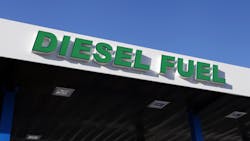Diesel prices fall with demand, but could rise with summer travel
Motor club AAA measured the price of diesel fuel to be $5.726 per gallon on July 5, making the current price 6 cents lower than last week’s U.S. average but 9 cents higher than last month’s. The average price of trucking's main fuel this time last year was $3.252 per gallon, $2.474 less than the July 5 average.
Falling prices at the pump come as demand falls with fewer consumers fueling up. July, however, is the heaviest month for gasoline demand as Americans travel for their summer vacations. The slight relief people feel at the pump might be short-lived as increased demand for petroleum products signals a corresponding rise in prices.
The Energy Information Administration (EIA) offers weekly data that typically is used in diesel price reports, but server damage caused by voltage irregularities have meant the federal agency has not updated its diesel prices since June 13.
“We are currently running additional systems testing for the collection and calculation of the data,” EIA stated. “We will publish data for U.S. and regional average diesel prices for June 20, June 27, and July 4, as soon as we can.”
EIA began to post its gasoline price data again on June 29 after the outage caused a 16-day delay. As of July 4, the national average for gas was $4.771 a gallon, 10.1 cents less than a week ago and 19.1 cents less than on June 20. EIA had gasoline down in every area of the country on July 4 except the Rocky Mountain region, where it was up about 2 cents. Still, EIA has the U.S. average for a gallon of gas almost $1.65 above the average of a year ago.
EIA also has been able to post other reports on energy markets outside of diesel.
On July 5, the price of crude oil had fallen below $100 per barrel for the first time since May. At the close of the formal trading session on July 1, the cost of a barrel of West Texas Intermediate crude oil had increased by $2.67 to $108.43 due to market optimism that demand will remain high throughout the summer. Despite last week’s increase, economic concerns due to rising interest rates, inflation, and the possibility of a recession tempered demand and lowered prices below the $100 mark.
On June 29, EIA reported that U.S. crude oil inventories decreased by 2.8 million barrels from the previous week, although distillate fuel inventories, which includes diesel, rose by 2.6 million barrels.
This story originally appeared on FleetOwner.
About the Author
Scott Keith
Digital Editor Scott Keith previously worked at the Kentucky Coalition Against Domestic Violence, where he did grant writing and communications work. He also taught English as a foreign language in Madrid for three years. Scott is a graduate of the University of Central Arkansas, where he studied journalism and creative writing.
